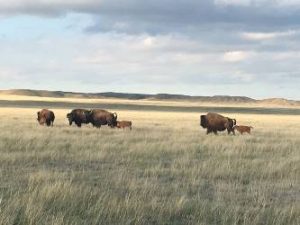In bison recovery, scientists start small

Up to 60 million bison once wandered the plains. The largest land mammal in North America, the bison is now recognized as a keystone species that helps maintain the ecology of grasslands. Their grazing habits influence the diversity of forbs and grasses, and their hooves help aerate the soil. Even their dirt wallows create seasonal habitat for birds and affect how fire moves through grasslands.
Today, there are an estimated 500,000 scattered across the plains but nearly all are managed as livestock, destined to become buffalo burger. Fewer than 21,000 are part of 62 “conservation herds” that are managed for environmental purposes with limited human intervention, and many of those have cattle genes. Even fewer genetically pure animals are considered truly free-roaming and “wild.” Many scientists consider the species to be ecologically extinct, meaning that its functional role in the landscape has been eliminated.
So while the reintroduction of 10 bison in Colorado’s Laramie Foothills may not sound like that big a deal, genetically pure conservation herds like this one are a crucial step toward restoring wild bison to the Western landscape. They could help calm ranchers’ longstanding worries about disease, and over time new herds have the potential to become self-sustaining populations that more closely resemble historic herds — if, that is, state and local managers are willing to give them room to grow.
“In bison recovery, scientists start small”
High Country News, April 6, 2016